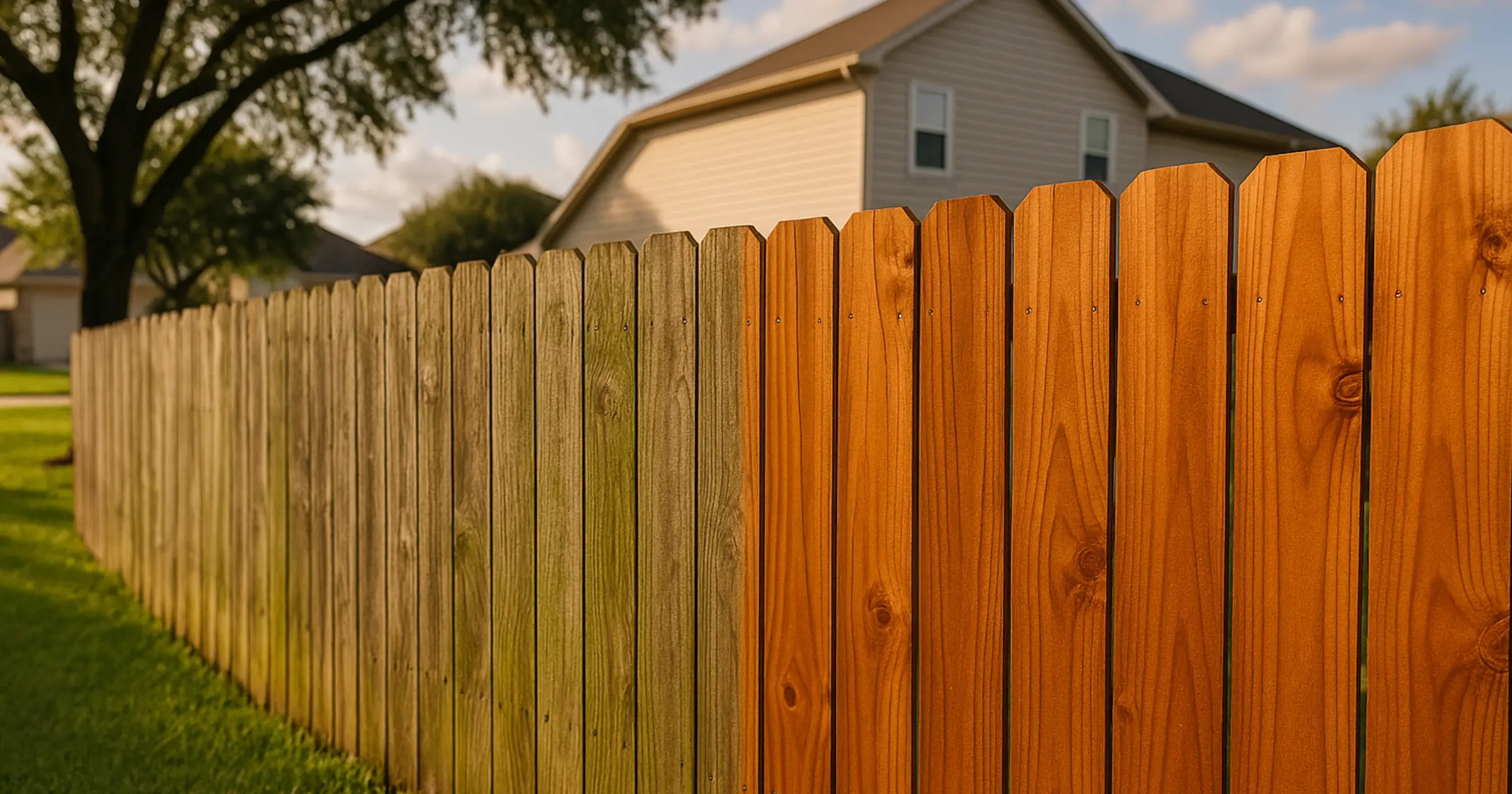
Green algae is eating your fence wood right now. Not staining it. Eating it.
Last week in Towne Lake, a homeowner called about “light green tint” on his fence. I showed him where the algae had already softened three fence boards. Cost him $180 to replace those boards because he waited six months thinking it was just dirt. The algae removal itself? $40 in bleach from Home Depot plus $45 in equipment.
Here’s the fastest DIY method to clean green algae before it rots your fence boards.
The fastest way to remove green algae (30-minute method)
The solution: 50/50 mix of 6% bleach and water in a pump sprayer.
Spray the affected area evenly. Wait 10 minutes. If algae hasn’t disappeared, spray again. For heavy growth, increase bleach concentration to 60-70% and apply multiple times. Rinse with a pressure washer on low setting (40-degree tip, 2 feet away from fence) for best results.
That’s the entire process. Everything else in this guide explains why it works and how to do it without damaging your fence or plants.
Why this method works (and why others fail)
Bleach kills algae at the root level. Green algae isn’t a surface stain like dirt. It’s a living organism with roots that penetrate wood grain. Surface cleaning with water or mild soap removes the green color temporarily but leaves the roots alive. Within 3-4 weeks, the algae returns darker than before.
Water dilution prevents wood damage. Straight bleach works faster but opens wood grain too aggressively, creating rough texture that absorbs water. The 50/50 dilution balances algae-killing power with wood protection.
The 10-minute wait is critical. Bleach needs time to penetrate wood pores where algae roots grow. Spraying and immediately rinsing only cleans the surface. We see this mistake on 80% of DIY attempts in Cypress—homeowners rush the process, then wonder why algae returns in three weeks.
Materials you need (100 ft section)
Required materials from Home Depot:
| Item | Cost | Link |
| Clorox Pro Results Outdoor Bleach (6% concentration, 4-5 gallons) | $40.00 | Home Depot |
| Scotts 2-Gallon Pump Sprayer | $29.98 | Home Depot |
| Heavy-Duty Latex Gloves | $6.98 | Home Depot |
| Milwaukee Safety Glasses | $7.98 | Home Depot |
| Total DIY Cost (100 ft) | $84.94 |
Professional Cost for Comparison: $200-300 for 100 ft section
Cost per linear foot: DIY $0.85/ft vs Professional $2-3/ft
Fence Bleach Calculator
Step-by-step application process
Step 1: Pre-wet the fence (5 minutes)
Use a garden hose to thoroughly wet all fence boards that have algae growth. This wets the wood fibers, which reduces how much bleach solution soaks into the wood, making your solution last longer and work more efficiently on the algae.
Step 2: Protect surrounding plants (10 minutes)
Thoroughly wet all grass and plants within 3 feet of your fence using your garden hose. Wet vegetation is less likely to absorb bleach overspray and suffer damage.
Plants most vulnerable to bleach damage:
- Newly planted flowers (will likely die)
- Hostas and ferns (brown leaves within 24 hours)
- Azaleas and hydrangeas (leaf burn)
Step 3: Prepare the bleach solution (5 minutes)
CRITICAL: Always add water to the sprayer FIRST, then add bleach. Never add bleach first then water—this creates concentrated bleach vapor that’s dangerous to breathe.
Standard mix ratio:
- 1 gallon water
- 1 gallon bleach (6% concentration)
- = 50/50 solution for light to moderate algae
Heavy algae mix (for thick, dark green coverage):
- 0.75 gallons water
- 1.25 gallons bleach
- = 60/40 solution
Close the pump sprayer lid tightly and pump 10-15 times to pressurize.
Step 4: Wear safety equipment (MANDATORY)
Before touching the sprayer or starting application:
- [ ] Put on latex gloves (bleach burns skin)
- [ ] Put on safety glasses (bleach splashes during spraying)
What happens if you skip safety gear: Bleach splashes cause eye irritation and skin contact causes chemical burns that appear 2-3 hours later. We see burns on homeowner’s forearms weekly from people who “didn’t think they needed gloves.”
Step 5: Apply the bleach solution (10-15 minutes)
Sprayer settings:
- Use the fan tip (widest spray pattern)
- Hold nozzle 12-18 inches from fence
- Spray in smooth, overlapping horizontal passes
Application pattern (spray from bottom to top):
- Start at fence bottom near ground level
- Work upward in 2-foot-wide horizontal sections
- Overlap each pass by 6 inches for even coverage
- Ensure complete saturation—fence should look wet, not damp
Step 6: Wait and monitor (10 minutes minimum)
Set a timer for 10 minutes after completing application. Do NOT rinse early.
What you’ll see during the wait:
- Minutes 1-3: No visible change
- Minutes 4-6: Green color starts fading to yellow-brown
- Minutes 7-10: Most algae should be gone or significantly lighter
If algae is still visible after 10 minutes: Apply a second coat immediately. Some algae colonies are thicker and need double treatment. This is normal for fences that have had algae for 4+ months.
Step 7: Second application (if needed, add 10 minutes)
For stubborn algae that didn’t fully disappear after the first application:
- Mix stronger solution (60% bleach, 40% water)
- Apply directly to remaining algae spots
- Wait another 10 minutes
- Check results
When to use stronger concentration: If you can still see distinct green patches after first application and 10-minute wait. Don’t guess, if it’s green, it needs more treatment.
Step 8: Pressure wash (for heavy algae only)
Only needed for: Thick, dark green algae that’s been present for 6+ months.
Pressure washer settings:
- Low pressure: 500-800 PSI maximum
- 40-degree tip (widest spray pattern)
- Hold nozzle 24 inches from fence
- Never use 0-degree or 15-degree tips (these gouge wood)
Rinse pattern: Spray in same direction as wood grain, moving smoothly without stopping in one spot. Stopping creates pressure marks that show up after staining.
If you don’t have a pressure washer: Garden hose on jet setting works for light to moderate algae after bleach treatment. You don’t need a pressure washer unless algae is extremely heavy.
When DIY algae removal won’t work
You need professional help when:
1. Algae has been present for 12+ months
2. Wood feels soft when pressed
3. Algae returns within 4 weeks after DIY cleaning
4. More than 40% of fence has heavy algae
Why professional algae treatment lasts 5+ years
Commercial algaecides we use:
- Penetrate 8-10mm deep (vs. 2-3mm for bleach)
- Kill algae spores, not just active growth
- Create residual protection lasting 12-18 months
- Won’t strip wood grain or damage surrounding plants
Application equipment difference:
- Professional sprayers: 60-90 PSI for deep penetration
- Homeowner pump sprayers: 20-30 PSI (surface only)
- Results: 3x deeper chemical delivery
Wood brightener restoration: After algae removal, we apply wood brightener that:
- Neutralizes bleach residue
- Opens wood grain evenly for stain absorption
- Restores natural wood color
- Creates ideal surface for sealer adhesion
Professional stain + sealer:
- Penetrating oil-based stain with algaecide additives
- Water repellent that prevents moisture absorption
- UV blockers that slow wood breakdown
- 5-year protection guarantee
The key difference: We don’t just clean algae. We kill roots, restore wood, and seal the surface so algae can’t regrow. DIY cleaning removes visible algae but leaves wood vulnerable.
Common questions about DIY algae removal
Can I use a higher bleach concentration to work faster?
Yes, but don’t exceed 70% bleach concentration (70% bleach, 30% water). Higher concentrations open wood grain too aggressively, creating rough texture that’s difficult to stain smoothly.
Will this method damage my plants?
The overspray will damage any plants it contacts. That’s why Step 2 (pre-wetting vegetation) is mandatory, not optional.
Most vulnerable: Hostas, ferns, impatiens, azaleas, hydrangeas
Somewhat resistant: Established shrubs, mature trees, turfgrass
Very resistant: Liriope, monkey grass, Asian jasmine
Protection method: Thoroughly soak plants with garden hose before starting. Water dilutes any bleach that lands on leaves.
How many times can I clean algae before I need to replace the fence?
With staining between cleanings: Unlimited. The stain protects wood from bleach damage.
Without staining: 4-6 times maximum. Repeated bleach exposure without protective sealer degrades wood fibers. After 6 cleanings, wood becomes too rough to stain properly.
Can I use a lower bleach concentration to be safer?
Yes, but cleaning takes longer and may require more applications.
30% bleach concentration (30% bleach, 70% water):
- Works for very light, recent algae (less than 2 months old)
- Requires 20-30 minute wait time instead of 10 minutes
- Usually needs 2-3 applications
- Better for testing on small areas first
What if it rains before I can rinse the fence?
Rain dilutes the bleach solution and rinses the fence for you. This is actually ideal, natural rinse with no pressure washer needed.
However: If rain happens within 5 minutes of application, the solution may be too diluted to kill algae fully. Check fence after rain dries. If you still see green, reapply when fence dries.
Professional algae removal + prevention
If you’d rather spend your weekend doing anything besides spraying bleach on your fence, we handle complete algae removal and prevention in Cypress, The Woodlands, Katy, Spring, and Sugar Land.
Our process:
- Commercial algaecide application (kills roots, not just surface)
- Wood brightener restoration (prepares surface)
- Algae-resistant stain + sealer (5-year protection)
- Written guarantee (if algae returns in warranty period, we fix it free)
Average cost: $850-1,200 (complete removal + staining + 5-year protection)
Text us a photo of your fence: (832) 258-6164
We’ll tell you within 2 hours if DIY cleaning will work or if you need professional treatment. No pressure, honest assessment.
Most Cypress fences we see need professional treatment. DIY cleaning works but algae returns within 6-8 weeks without proper sealing. Our professional fence staining service combines commercial-grade products with expert application that solves the problem for 5+ years.

